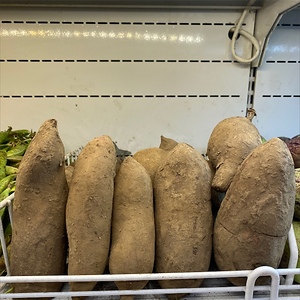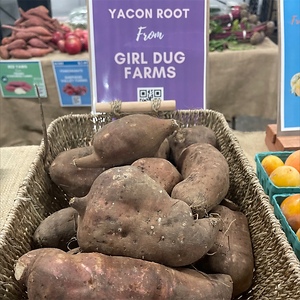


Yacón Root
Estimated Inventory, lb : 0
Description/Taste
Yacón roots are the underground storage roots of an herbaceous plant. It is important to note that the species has storage roots and rhizomes that develop in clusters underground, but only the storage roots are consumed. Yacón roots range in size from medium to large, extending 20 to 25 centimeters in length and 8 to 10 centimeters in diameter, and are generally harvested when they are 0.2 to 2.0 kilograms in weight. The roots appear in pyriform, cylindrical, to oval shapes and have a bulbous nature with tapered, slightly pointed ends. The skin is semi-thick, tough, and fibrous with a textured surface, and depending on the variety, the roots showcase yellow, purple, red-brown, pink, orange, to red hues. Underneath the skin, the flesh varies in color from beige to white, sometimes with an orange or purple tint. The flesh also has a crisp, tender, and aqueous consistency reminiscent of the texture of jicama, pears, and apples. Yacón roots can be consumed raw or cooked and have a refreshing, subtly sweet, and floral flavor with nuances of apple, celery, pear, and watermelon. The roots are relatively mild when harvested and develop a sweeter taste in storage after a week or two.
Seasons/Availability
Yacón roots are available in the late fall through winter.
Current Facts
Yacón, botanically classified as Smallanthus sonchifolius, is a South American species belonging to the Asteraceae family. The upright, leafy flowering plant grows up to 2.5 meters in height and produces an underground root that is harvested and utilized in medicinal and culinary preparations. Yacón roots are categorized as tuberous or storage roots, which mature approximately 6 to 8 months after planting. Each Yacón plant can produce 9 to 13 kilograms of roots per season and is known by several names, including Peruvian Ground Apple, Yacon, Yakon, Poire de Terre, Yacon Strawberry, Ground Pear, and Strawberry Jicama. Historically, Yacón was localized to regions of South America and was grown as a culinary and medicinal root. Over time, the species was cultivated and bred to develop more varieties, and the plants were spread worldwide, where they remain a relatively rare root only planted on a small scale.
Nutritional Value
Yacón roots are a source of fiber to regulate the digestive tract, vitamin C to strengthen the immune system, and potassium to balance fluid levels within the body. The roots also provide calcium to build strong bones and teeth, magnesium to regulate optimal nerve functioning, phosphorus to repair tissues, and antioxidants to protect the cells against the damage caused by free radicals. One of the unique traits of Yacón is its high levels of fructooligosaccharide, a type of sugar that cannot be broken down by the digestive system, making the sugar unmetabolized, keeping the roots low in calories. Fructooligosaccharide can aid digestion and feed beneficial gut bacteria, which can play an essential role in overall health. In South America, Yacón roots can be boiled into a thick, sweet syrup and are used in natural medicines to reduce inflammation.
Applications
Yacón has a mild, refreshing, and sweet taste suited for fresh and cooked preparations. The roots are typically consumed raw, favored for their crisp and juicy nature, and the skin can be peeled, and the flesh sliced and served as a snack. The flesh can also be eaten with dips, displayed on charcuterie boards, or chopped and tossed into salads. Try mixing Yacón with dressings, herbs, citrus juice, and vinaigrettes for enhanced flavoring. The roots can also be integrated into fruit medleys or fermented into pickles as a tangy condiment. In South America, Yacón is incorporated into salpicon, a salad comprised of tropical fruits and fresh citrus juice. In addition to fresh dishes, Yacón can be tossed into stir-fries, fried into tempura, added to curries, baked into chips, or boiled and served as a vegetable. The roots can also be used to flavor baked goods, blended and frozen into ice cream, drizzled with honey, or added to other sweet desserts. Yacón syrup is created from boiled roots and is a popular sweetener for drinks, candies, and desserts. Beyond the roots, the young leaves are used in medicinal teas. Yacón pairs well with sunflower seeds, pumpkin seeds, fruits such as strawberries, mango, papaya, pineapple, and herbs including parsley, cilantro, and chives. Whole, unwashed Yacón roots can be wrapped in newspaper and stored in a cool, dry, and dark place for up to ten days. Once opened, the roots can be wrapped in plastic and stored in the refrigerator.
Ethnic/Cultural Info
Legend has it that Yacón roots were grown along select trails and pathways of the Incas in Peru. When Incan messengers were traveling back and forth to deliver news, they would dig up the roots as a source of hydration. The roots would also provide some nourishment to fuel the messengers to keep them on their journeys. Yacón roots are also depicted on stirrup vessels from the Moche people in Peru. These vessels were often shaped into familiar crops of the region, such as Yacón, and had long spouts at the top of the vessel to prevent liquids from spilling. The vessels were also made to prevent evaporation. Some historians believe stirrup vessels and other pottery items were placed with deceased bodies in Moche burials, thinking that the vessels could be used as a gift in the afterlife.
Geography/History
Yacón is native to South America, specifically the Andean region, and has been growing wild since ancient times. The species is found from Colombia to Argentina and is grown on farms along the eastern slopes of the Andes mountains, an area known as the Yungas. Throughout South America, Yacón plants were sown on the edges of fields, and the roots were harvested as refreshing snacks for field workers. The roots were consumed by indigenous communities and were used throughout history as a food and medicinal source. The Incas also incorporated Yacón into their diets, and when the Spanish arrived, they harvested the roots as a water source. In the 1960s, Yacón was introduced to New Zealand and was planted commercially by the late 1970s. The species was also sent to Japan from New Zealand in 1984 and was bred to create four new varieties for commercial production in the early 21st century. After its introduction in Japan, Yacón became a popular crop for its nutritional properties. Yacón was also spread to other regions of Asia, Europe, Australia, and the United States in the late 19th century. Today Yacón is grown worldwide, with concentrated commercial production in South America, New Zealand, and Japan. In Japan, the species is grown in Fukushima, Kumamoto, Hokkaido, Iwate, Aichi, Shimane, Shiga, and Fukuoka prefectures. Yacón is available in fresh markets in its growing region. The roots are sometimes exported outside its growing area through select retailers and distributors.
Recipe Ideas
Recipes that include Yacón Root. One
| Fast Juice Diet |
|
Yacon Juice and Yogurt |
| ABC |
|
Yacon and Strawberry Fruit Salad |
| The Gardener's Pantry |
|
Yacon Carrot Salad with Wasabi |

















